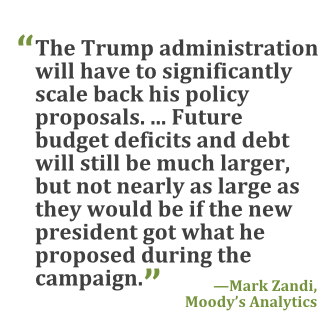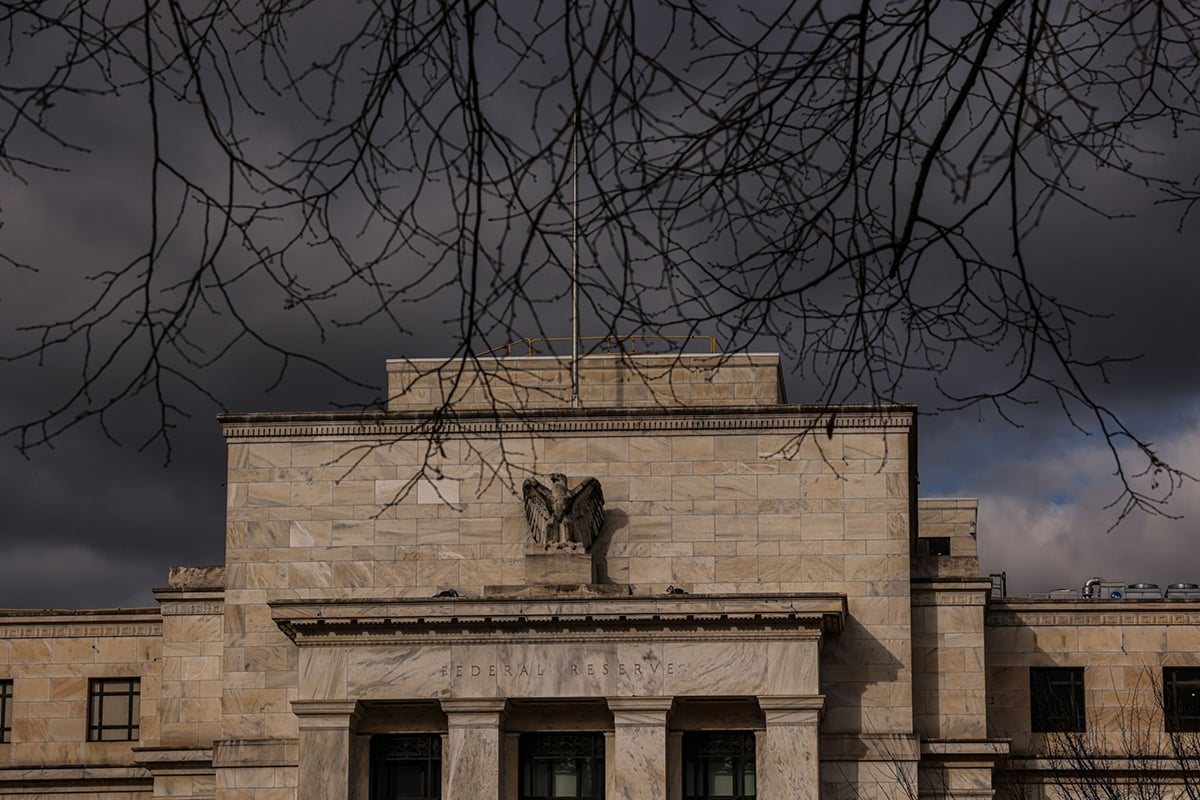In the afterglow of Donald Trump's unexpected triumph,Republicans exulted over what they could accomplish with control ofboth chambers of Congress and the White House.
|But behind the public show of unity, a stark differencelooms. House Speaker Paul Ryan is a fiscal hawk who wantsto couple tax cuts with deep spending cuts. Trump catapultedhimself into the presidency talking about tax cuts too, buthe also is proposing a multibillion-dollar infrastructure planand has vowed to protect entitlement programs like Social Securityand Medicare.
|Such gaps went unmentioned when Trump met with Ryan and SenateMajority Leader Mitch McConnell last week. But ultimately, oneside will have to bend, whether Trump ends up moderating hisspending and tax-cut plans, or congressional fiscal hawks relent ontheir opposition to new spending.
| The signs of a looming clash are already there. One dayafter meeting with Trump, McConnell poured cold water on Trump'sspending plans, telling reporters that a government stimulus wasn'tgoing to help the economy.
The signs of a looming clash are already there. One dayafter meeting with Trump, McConnell poured cold water on Trump'sspending plans, telling reporters that a government stimulus wasn'tgoing to help the economy.
“A government spending program is not likely to solve thefundamental problem of growth,” he said Friday.
|But Trump mentioned only one policy proposal during his victoryspeech last week: his infrastructure plan.
|“We are going to fix our inner cities and rebuild our highways,bridges, tunnels, airports, schools, hospitals. We're going torebuild our infrastructure, which will become, by the way, secondto none,” he said. “And we will put millions of our people to workas we rebuild it.”
|Such a plan may be too much for congressional Republicans toswallow, and Ryan and McConnell haven't backed it.
|But House Majority Leader Kevin McCarthy of California showedsome softening on the issue Monday, telling reporters that aninfrastructure bill can be “a priority” and “a bipartisan issue.”He said there can be ways to pay for it, though he didn't providespecifics.
|“Infrastructure in America is lagging far behind,” McCarthysaid, noting that Congress passed a highway bill this year for thefirst time in more than a decade.
|Anthony Scaramucci, an economic adviser named to Trump's16-member transition executive committee, cited thepresident-elect's US$1 trillion infrastructure plan, saying itwould be financed by “historically cheap debt” and private-publicpartnerships.
|“We can close the wealth gap in America by replacingemergency-level interest rates with fiscal stimulus,” Scaramucci,the founder of the investment firm SkyBridge Capital, wrote in anop-ed in the Financial Times last week.
|Ryan and House Republicans have spent the past six yearsenforcing strict budget caps aimed at holding down the federaldebt. Republicans even took the government to the brink of defaultin a battle over raising the debt limit.
|“As we move from campaigning to governing, something will haveto give since cutting taxes without major spending cuts will makeour already unsustainable debt situation even worse,” says MayaMacGuineas, president of the non-partisan Committee for aResponsible Federal Budget in Washington.
|These differences may take some time to emerge. Republicanleaders last week talked up the many areas where they arebroadly in sync with Trump, including repealing and replacingObamacare and dismantling President Barack Obama's financial andenvironmental regulations. And the appointment of RepublicanNational Committee Chairman Reince Priebus, a close Ryan ally, asTrump's chief of staff will reassure congressional Republicans thatthere is a path to enact a broad GOP agenda.
|Still, Trump campaigned on a series of plans that, takentogether, would increase the deficit dramatically. Those includethe infrastructure plan, as well as building a wall along theU.S.-Mexico border, changing immigration and trade policies, andboosting military spending—all while slashing corporate andpersonal taxes.
'Debt Bomb'
Representative David Brat of Virginia, a member of theultra-conservative House Freedom Caucus, said Friday that membersare on board with much of Trump's agenda, but he wasn't willing topredict where they'd end up on his spending plans.
|Trump “has been thrown into a $20 trillion debt bomb scenario,”said Brat, who also noted the debate over whether the proposed taxcuts would add too much debt in the short term. But, Brat noted,the markets are saying “if you don't get the economy moving again,and particularly business capital investment, then the debt problemwill become catastrophic in 10 years.”
|Mark Zandi, chief economist at Moody's Analytics, expects Trumpwill be the one who has to compromise. “The Trump administrationwill have to significantly scale back his policy proposals for bothpolitical and economic realities,” he said.
||Trump hasn't provided much detail about his proposals, whichmakes it difficult to assess their potential impacts on the budgetdeficit. And that vagueness could give him room to scale back hisproposals and avoid accusations that he's reneging on campaignpromises. Indeed, Trump has hinted at times that his campaignpolicy statements were only opening salvos for anegotiation.
|But in general terms, Trump argues that his plans to lowercorporate and individual taxes, combined with deregulation, willgenerate higher economic growth—and that the growth will offsetmost of the lost tax revenue from his proposed cuts.
|He has also proposed a so-called penny plan to enact 1 percentbudget cuts annually to non-defense discretionary programs to reinin spending. But those cuts, which would exclude defense spendingand entitlements like Medicare and Social Security, would apply toa relatively small portion of government spending.
|The Committee for a Responsible Federal Budget projects thatTrump's proposals would add $16 trillion to the national debt over20 years—the result of $14.5 trillion of tax cuts, $2.5 trillion ofspending, and $3.8 trillion of higher interest costs.
|In just the next decade, according to estimates from theconservative Tax Foundation, Trump's tax plan would increase thenational debt between $4.4 trillion and $5.9 trillion.
|Republicans in Congress have also called for cuts in tax rates,but many want to pair those with steeper reductions to Medicare andSocial Security. During the campaign, however, Trump largely ruledout cuts to those programs.
|For now, McConnell, Ryan and other Republicans aren't talkingabout many of the specifics of Trump's proposals.
|“We're going to pursue the agenda that he talked about duringthe election,” McConnell said Friday. “Fundamentally I thinkthese people were not satisfied with the status quo and I thinkthat's what allowed him to win the election.”
|During the campaign, Ryan was dismissive of Trump'sinfrastructure plan. Ryan and McConnell also haven't supportedTrump's proposed building of a wall along the U.S.-Mexicoborder.
|“House Republicans are only just beginning to talk withPresident-elect Trump and Vice President-elect Pence about theagenda for 2017,” Ryan spokeswoman AshLee Strong said in astatement. “Speaker Ryan intends to continue these discussions withthe transition team.”
Debt Limit
An early debate looms next year over how to address thedebt-limit moratorium, which expires this spring.
|A House Democrat, Gerry Connolly of Virginia, predicted in aninterview that, over time, rifts will emerge with the House andSenate Republican leaders over Trump's proposals. Those tensionswill grow, he said, as campaign promises aren't kept and fightsbrew, and voters will see him as the “snake oil salesman heis.”
|But Zandi predicts Trump and congressional Republicans will cometo a compromise, with lawmakers agreeing to tax cuts that areone-third the size of what Trump has proposed—perhaps closer to $2trillion.
|“Future budget deficits and debt will still be much larger, butnot nearly as large as they would be if the new president gotprecisely what he proposed during the campaign,” he said.
|Copyright 2018 Bloomberg. All rightsreserved. This material may not be published, broadcast, rewritten,or redistributed.
Complete your profile to continue reading and get FREE access to Treasury & Risk, part of your ALM digital membership.
Your access to unlimited Treasury & Risk content isn’t changing.
Once you are an ALM digital member, you’ll receive:
- Critical Treasury & Risk information including in-depth analysis of treasury and finance best practices, case studies with corporate innovators, informative newsletters, educational webcasts and videos, and resources from industry leaders.
- Exclusive discounts on ALM and Treasury & Risk events.
- Access to other award-winning ALM websites including PropertyCasualty360.com and Law.com.
*May exclude premium content
Already have an account? Sign In
© 2024 ALM Global, LLC, All Rights Reserved. Request academic re-use from www.copyright.com. All other uses, submit a request to [email protected]. For more information visit Asset & Logo Licensing.







